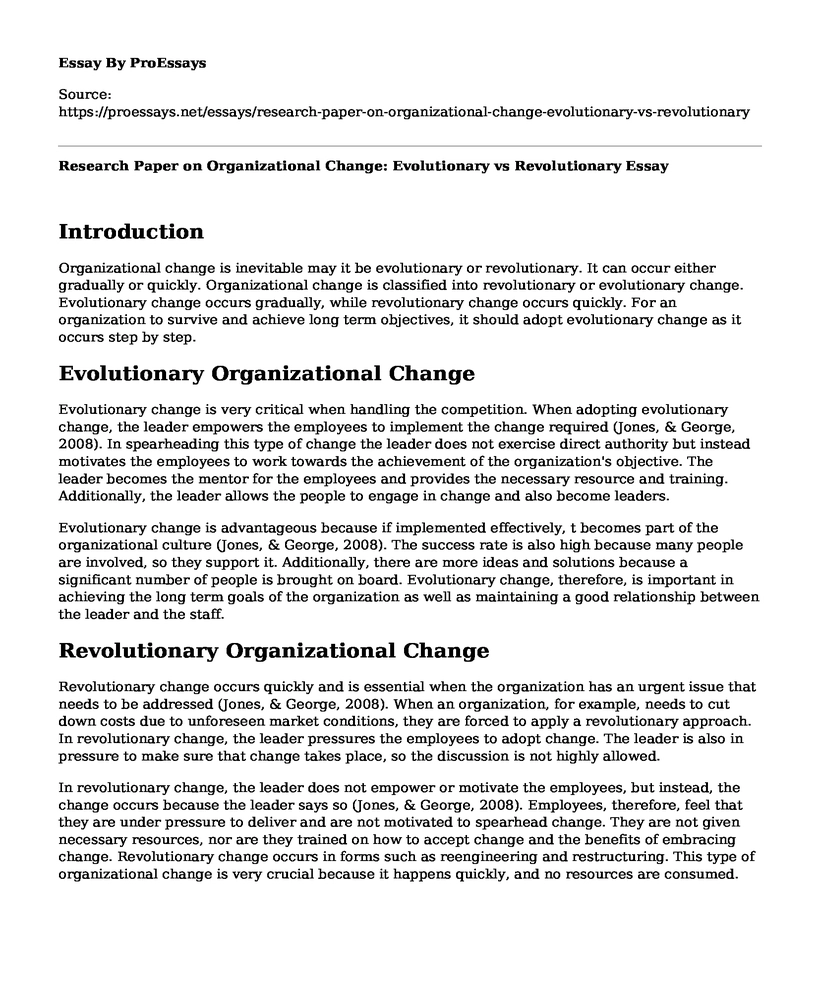Introduction
Organizational change is inevitable may it be evolutionary or revolutionary. It can occur either gradually or quickly. Organizational change is classified into revolutionary or evolutionary change. Evolutionary change occurs gradually, while revolutionary change occurs quickly. For an organization to survive and achieve long term objectives, it should adopt evolutionary change as it occurs step by step.
Evolutionary Organizational Change
Evolutionary change is very critical when handling the competition. When adopting evolutionary change, the leader empowers the employees to implement the change required (Jones, & George, 2008). In spearheading this type of change the leader does not exercise direct authority but instead motivates the employees to work towards the achievement of the organization's objective. The leader becomes the mentor for the employees and provides the necessary resource and training. Additionally, the leader allows the people to engage in change and also become leaders.
Evolutionary change is advantageous because if implemented effectively, t becomes part of the organizational culture (Jones, & George, 2008). The success rate is also high because many people are involved, so they support it. Additionally, there are more ideas and solutions because a significant number of people is brought on board. Evolutionary change, therefore, is important in achieving the long term goals of the organization as well as maintaining a good relationship between the leader and the staff.
Revolutionary Organizational Change
Revolutionary change occurs quickly and is essential when the organization has an urgent issue that needs to be addressed (Jones, & George, 2008). When an organization, for example, needs to cut down costs due to unforeseen market conditions, they are forced to apply a revolutionary approach. In revolutionary change, the leader pressures the employees to adopt change. The leader is also in pressure to make sure that change takes place, so the discussion is not highly allowed.
In revolutionary change, the leader does not empower or motivate the employees, but instead, the change occurs because the leader says so (Jones, & George, 2008). Employees, therefore, feel that they are under pressure to deliver and are not motivated to spearhead change. They are not given necessary resources, nor are they trained on how to accept change and the benefits of embracing change. Revolutionary change occurs in forms such as reengineering and restructuring. This type of organizational change is very crucial because it happens quickly, and no resources are consumed.
Reengineering
Reengineering constitutes rethinking of the processes of the businesses to improve in aspects such as service, quality, speed as well as cost (Jones, & George, 2008). The managers of organizations that believe in the power of reengineering focus on business processes instead of the functions of the organization. Where the revolutionary change is required processes such as inventory control, designing the product suitably ad processing are very critical.
Restructuring
The main objective of restructuring is to help recover from massive performance deterioration. Restructuring helps in eliminating aspects such as departments, divisions, and leadership hierarchy. Such an organization also resources to downsizing with an attempt f cutting down the costs that re-incurred to run the organization (Jones, & George, 2008). A company adopting restricting approach also outsources manufacturing services, customer services as well as functional activities from other companies. Such changes are very critical when an organization experiences external changes that were unforeseen. A change in technology, for example, may affect an organization to the extent of making its products or services unnecessary in the market.
Conclusion
In conclusion, change is inevitable; may it be revolutionary or evolutionary. Evolutionary change occurs slowly, while revolutionary change occurs quickly. Organizations adopt evolutionary change due to external pressure change in technology. The organization also adopts evolutionary change when they need to keep up with the pressure from the stakeholders. On the other hand, they adopt revolutionary change when they are faced with an issue requiring urgency.
References
Jones, G. R., & George, J. M. (2008). Understanding and managing organizational behavior. Pearson Prentice Hall.
Cite this page
Research Paper on Organizational Change: Evolutionary vs Revolutionary. (2023, Feb 12). Retrieved from https://proessays.net/essays/research-paper-on-organizational-change-evolutionary-vs-revolutionary
If you are the original author of this essay and no longer wish to have it published on the ProEssays website, please click below to request its removal:
- Comparative Government and Politics - China
- Strategy, Organization, and Opportunity Assessment
- Essay Sample on Apple Inc. Strategy Implementation
- The Elasticity of a Product: Claire's Makeup Products Paper Example
- Essay Sample on ABF: A Multinational Food Retail & Ingredient Company
- Luxury Car Co. Aims to Double Sales in Market - Essay Sample
- Paper Example on THS Strategy: Enhancing Ambulatory Strategies Through Data Integration







